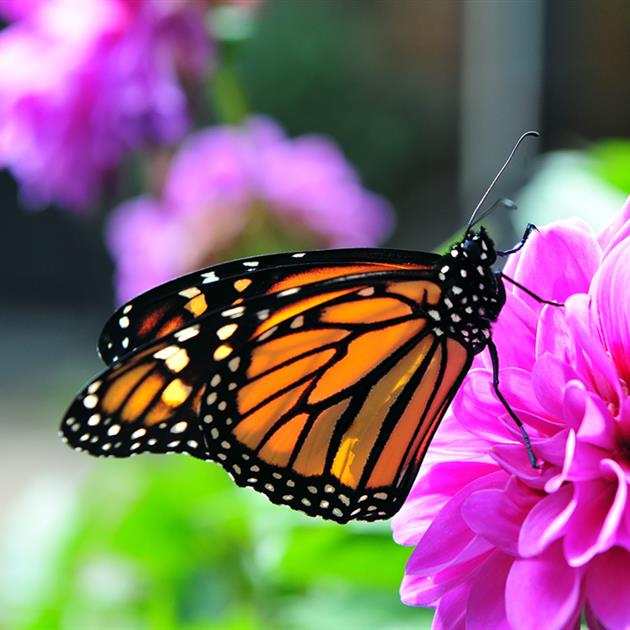
PRESERVING THE REIGN OF THE MONARCH
With its orange wings and black markings, the Monarch butterfly is one of the most recognizable and studied butterflies in the world. Its annual migration between Canada and Mexico is a well-documented and awe-inspiring feat and its arrival in Muskoka seems to really herald the arrival of summer.
Capturing the black, yellow and white caterpillars and watching them create the stunning green and gold chrysalis to transform into a butterfly has been a pastime of kids everywhere. It has also become a pastime of many adults across the continent who are committed to helping continue the reign of the Monarch.
Huntsville resident Suzanne Baxter has spent the past three summers learning about Monarchs and helping the caterpillars in her garden become butterflies. She first became involved in the process when she received a scolding from her neighbour.
“I had cut down a pile of milkweeds that were in front of my house. It was a new house and I thought they were just weeds,” she said. Her neighbour, who had come for a visit, had a keen interest in the Monarchs. Baxter said she took one look at her garden and was aghast that she had cut the plants down. Monarch caterpillars feed almost exclusively on milkweed.
“I had no idea,” Baxter said. “I had never really paid attention to the Monarch prior to that, other than thinking they were a beautiful butterfly.”
Baxter said she likes to think she is very environmentally conscious and was mortified when she learned what she had done. So, she decided to educate herself and started to research the Monarch on the internet.
“I discovered a Facebook page, The Beautiful Monarch, which is a continent-wide page with a wealth of information and comments,” she said. “I was surprised at how many thousands of people there are who are helping to raise Monarchs.” The Facebook page has almost 34,000 followers.
Baxter learned the fate of the Monarch is precarious because of climate change, loss of habitat, parasites, pesticides and predators, and she made the decision to help the ones she could. Her first summer was a huge learning curve and she discovered raising Monarchs is a lot of work.
“There is so much information about them, because there is so much involved in raising them,” she said. There is the egg, caterpillar, chrysalis and butterfly stage and each one is complicated, if you are to raise them properly.
The first job is finding the caterpillar which is then placed in a container with a mesh lid to keep it contained. The caterpillars eat almost constantly, so it is imperative to continuously replenish the container with milkweed as well as keep the container clean from the continuous caterpillar poop. The caterpillar moults five times, known as instar stages and when it reaches the fifth stage, it must be moved to another container where the caterpillar will attach itself in a J-shape and become a chrysalis. It takes between nine to 14 days for a caterpillar to complete all five instar stages. The caterpillar will spend another 10 to 12 days as a chrysalis before finally emerging as a butterfly.
Baxter said it is important to keep the process outside to allow the caterpillars to be kept in their natural environment.
“Basically, what we are trying to do is give the Monarchs the best protection we can,” she said. “First and foremost against the Tachinid fly, that will lay its eggs inside the caterpillar which will kill the caterpillar.”
It is a lot of work and Baxter says you need be dedicated and committed. But it is also hugely satisfying when a healthy butterfly emerges and flies away. She adds, when a butterfly emerges, you can tell right away if it is in trouble and won’t survive. She finds that heartbreaking. “You do get emotionally attached,” she says.
At one point, Baxter had 15 chrysalis and estimates she has released 80 new butterflies. If people are not able to do the work involved in raising the caterpillars, Baxter said they can always help the species by simply not using pesticides and not removing the milkweed. And it is a good start to educate yourself on what a milkweed plant looks like.
Baxter wishes Huntsville would establish a Monarch Watch Waystation which is a location created to provide an oasis for the Monarch. There needs to be ample milkweed and space for the creatures.
As well, education is so imperative to help the Monarch survive. Many milkweed plants are cut down by municipalities when they are cutting ditches. People have placed signs in heavy growth areas in hopes the drivers will lift the blade in those areas sparing the milkweed and the caterpillars.
As of May 17, there were 28,210 Monarch Waystation habitats registered with Monarch Watch. Interested parties can contact Monarch Watch through its website at Monarchwatch.org and be a part of the group committed to ensuring the survival of the Monarch.
